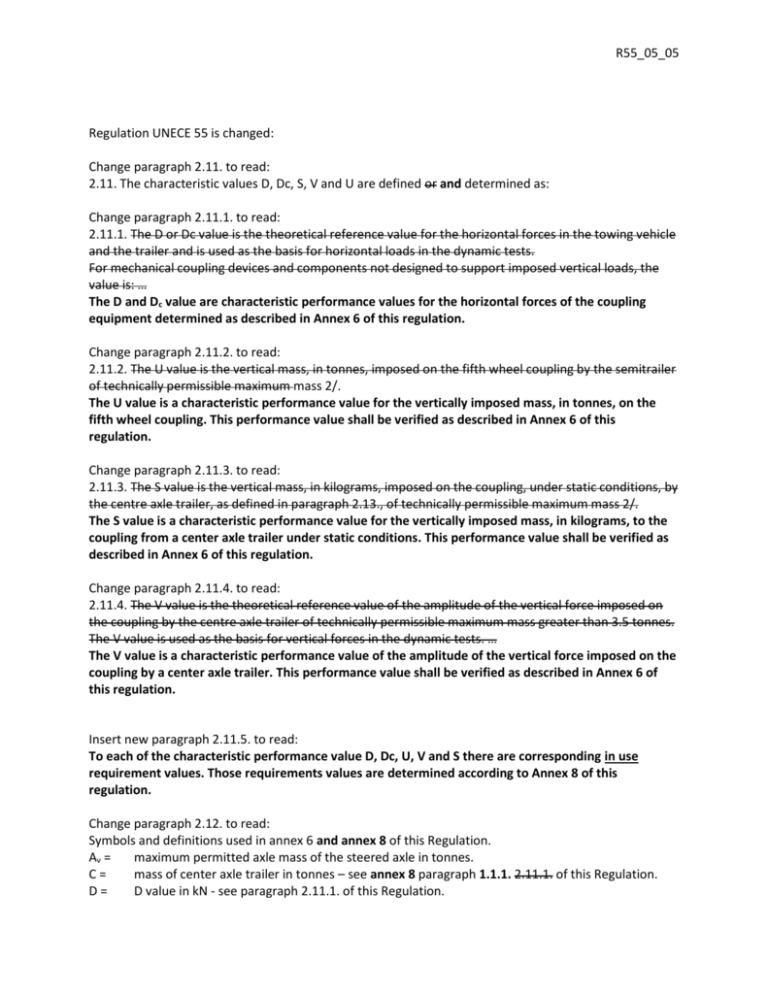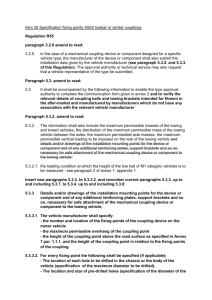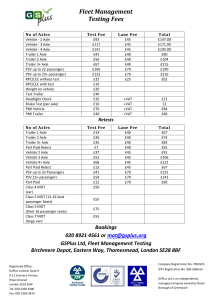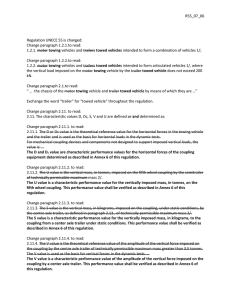Mechanical couplings
advertisement

R55_05_05 Regulation UNECE 55 is changed: Change paragraph 2.11. to read: 2.11. The characteristic values D, Dc, S, V and U are defined or and determined as: Change paragraph 2.11.1. to read: 2.11.1. The D or Dc value is the theoretical reference value for the horizontal forces in the towing vehicle and the trailer and is used as the basis for horizontal loads in the dynamic tests. For mechanical coupling devices and components not designed to support imposed vertical loads, the value is: … The D and Dc value are characteristic performance values for the horizontal forces of the coupling equipment determined as described in Annex 6 of this regulation. Change paragraph 2.11.2. to read: 2.11.2. The U value is the vertical mass, in tonnes, imposed on the fifth wheel coupling by the semitrailer of technically permissible maximum mass 2/. The U value is a characteristic performance value for the vertically imposed mass, in tonnes, on the fifth wheel coupling. This performance value shall be verified as described in Annex 6 of this regulation. Change paragraph 2.11.3. to read: 2.11.3. The S value is the vertical mass, in kilograms, imposed on the coupling, under static conditions, by the centre axle trailer, as defined in paragraph 2.13., of technically permissible maximum mass 2/. The S value is a characteristic performance value for the vertically imposed mass, in kilograms, to the coupling from a center axle trailer under static conditions. This performance value shall be verified as described in Annex 6 of this regulation. Change paragraph 2.11.4. to read: 2.11.4. The V value is the theoretical reference value of the amplitude of the vertical force imposed on the coupling by the centre axle trailer of technically permissible maximum mass greater than 3.5 tonnes. The V value is used as the basis for vertical forces in the dynamic tests. … The V value is a characteristic performance value of the amplitude of the vertical force imposed on the coupling by a center axle trailer. This performance value shall be verified as described in Annex 6 of this regulation. Insert new paragraph 2.11.5. to read: To each of the characteristic performance value D, Dc, U, V and S there are corresponding in use requirement values. Those requirements values are determined according to Annex 8 of this regulation. Change paragraph 2.12. to read: Symbols and definitions used in annex 6 and annex 8 of this Regulation. Av = maximum permitted axle mass of the steered axle in tonnes. C= mass of center axle trailer in tonnes – see annex 8 paragraph 1.1.1. 2.11.1. of this Regulation. D= D value in kN - see paragraph 2.11.1. of this Regulation. R55_05_05 DC = R= T= Fa = Fh = Fs = S= U= V= a= e= f= g= . L= X= DC value for center axle trailers - see paragraph 2.11.1. of this Regulation. mass of towed vehicle in tonnes - see annex 8 paragraph 1.1.1. 2.11.1. of this Regulation. mass of towing vehicle in tonnes - see annex 8 paragraph 1.1.1. 2.11.1. of this Regulation. static lifting force in kN. horizontal component of test force in longitudinal axis of vehicle in kN. vertical component of test force in kN. static vertical mass in kg. - see paragraph 2.11.3. of this Regulation. fifth wheel imposed vertical mass in tonnes. - see paragraph 2.11.2. of this Regulation. V-value in kN - see paragraph 2.11.4. of this Regulation. equivalent vertical acceleration factor at the coupling point of center axle trailers depending on the type of suspension of the rear axle(s) of the towing vehicle. see annex 8 paragraph 1.1.2. 2.11.4. of this Regulation. longitudinal distance between the coupling point of coupling balls which can be dismantled and the vertical plane of the fixing points (see Figures 20c to 20f) in mm. vertical distance between the coupling point of coupling balls which can be dismantled and the horizontal plane of the fixing points (see Figures 20c to 20f) in mm. acceleration due to gravity, assumed as 9.81 m/s2 theoretical drawbar length between the center of the drawbar eye and the center of the axle assembly in meters. length of the loading area of a center axle trailer in meters. Subscripts: O= maximum test force U= minimum test force a= static force h= horizontal p= pulsating res = resultant s= vertical w= alternating force Change paragraph 5.3.5. to read: 5.3.5. a statement of the characteristic performance values of D, Dc, S, V and U as applicable and as defined in paragraph 2.11.; Change paragraph 5.3.5.1. to read: 5.3.5.1. The characteristic performance values shall be at least equal to those requirement values applicable to the maximum permissible towing vehicle, trailer and combination masses, determined according to Annex 8 of this regulation. R55_05_05 Insert new Annex 8 to read: Annex 8 IN USE REQUIRED PERFORMANCE 1. In use requirement values are determined as: 1.1. Two vehicle combinations 1.1.1. Horizontal forces For mechanical coupling devices and components not designed to support imposed vertical loads, the value is: 𝑻∗𝑹 𝑫𝒓𝒆𝒒 = 𝒈 𝑻+𝑹 kN For mechanical coupling devices and components for center axle trailers as defined in 2.13, the value is: 𝑫𝑪−𝒓𝒆𝒒 = 𝒈 𝑻∗𝑪 𝑻+𝑪 kN For fifth wheel couplings of Class G, fifth wheel coupling pins of Class H and mounting plates of Class J, as defined in paragraph 2.6., the value is: 𝑫𝒓𝒆𝒒 = 𝒈 𝟎.𝟔∗𝑻∗𝑹 𝑻+𝑹−𝑼 kN where: T R C is the technically permissible maximum mass of the towing vehicle, in tonnes. Where relevant, this includes the vertical load imposed by a center axle trailer. 1/ is the technically permissible maximum mass, in tonnes, of a trailer with drawbar free to move in a vertical plane, or of a semitrailer. 1/ is the mass, in tonnes, transmitted to the ground by the axle or axles of the center axle trailer, as defined in paragraph 2.13., when coupled to the towing vehicle and loaded to the technically permissible maximum mass 1/. For Category O1 and O2 center axle trailers 1/ the technically permissible maximum mass will be that declared by the manufacturer of the towing vehicle. 1/ The mass T and R and the technically permissible maximum mass, may be greater than the permissible maximum mass prescribed by national legislation. 2/ See definitions in Regulation No. 13 annexed to the 1958 Agreement concerning the Adoption of Uniform Technical Prescriptions for Wheeled Vehicles, Equipment and Parts which can be Fitted and/or be Used on Wheeled Vehicles and the Conditions for Reciprocal Recognition of Approvals Granted on the Basis of these Prescriptions. The definition is also contained in annex 7 of the Consolidated Resolution on the Construction of Vehicles (R.E.3) (document TRANS/WP.29/78/Rev.1/Amend.2). R55_05_05 1.1.2. Vertical forces from center axle trailer The vertical force imposed on the coupling by the center axle trailer of technically permissible maximum mass greater than 3.5 tonnes is: 𝑽𝒓𝒆𝒒 = 𝒂∗𝑪∗𝑿𝟐 𝑳𝟐 kN (See the Note below) where: C is as defined in paragraph 1.1.1. of this Annex a is an equivalent vertical acceleration at the coupling depending on the type of suspension system of the rear axle of the towing vehicle. For air suspension (or suspension systems with equivalent damping characteristics) a = 1.8 m/s2 For other types of suspension: a = 2.4 m/s2 X is the length of the loading area of the trailer, in meters (see Figure 27) L is the distance from the center of the drawbar eye to the center of the axle assembly, in meters (see Figure 27) Note: 𝑿𝟐 𝑳𝟐 ≥ 𝟏. 𝟎 (If less than 1.0, the value of 1.0 shall be used) Figure 27 Dimensions of the center axle trailer 1.2. Multi vehicle combinations For multi vehicle combinations the requirement values shall be calculated as described in ISO18868:2013. A general prerequisite for the application of ISO18868 is that the stability of the combination is demonstrated. R55_05_05 2. Operation In paragraph 5.3.5.1. the general requirement on the characteristic performance values is stated. 2.1. To account for the influence of a support load different from S the definition. Vallowable ≤ V – 0,5*(Sreq – S)*g/1000 is made. 2.2. When Sreq ≥ S the combined required DC-req and Vreq shall fulfil the inequalities: 𝐕𝐫𝐞𝐪 𝐃𝐂−𝐫𝐞𝐪 − 𝐃𝑪 ≤𝟏− 𝐕𝐚𝐥𝐥𝐨𝐰𝐚𝐛𝐥𝐞 𝐃 − 𝐃𝐂 Vreq ≤ Vallowable 2.3. When Sreq ≤ S and if it can be positively shown that the certified support load S on its own, causes tensile stresses at the critical locations of the two way certification test, then the inequalities in the above paragraph can be applied. Note! If the tensile stresses from the support load cannot be positively shown the inequalities do not apply for Sreq ≤ S. Retesting is required to determine new performance values. 3. Extreme transport requirements 3.1. TBD R55_05_05 Justification Changes to §2.11.x. There is a common mix up and misunderstanding of what is performance and what is requirement. When type approving coupling equipment, you do not usually have a specific vehicle or vehicle combination in mind. Rather you have for instance a general combination in mind. Considering for instance a market where you have a 60 tonnes maximum combination mass (MCM) limitation. Then from the formulas in the new Annex 8 you know that a D-value or DC-value of g*MCM/4 = 147 kN enough. Once you decided what performance value you would like your coupling to have the procedures to verify the performance are set out in Annex 6. In case we deal with standard couplings like class C-50 the minimum D- or DC-values are already set in the regulation. Hence in 2.11.x. we define the performance values and tell that there are corresponding requirements. The formulae in 2.11.1. and 2.11.4. are in reality tools how to decide the performance values required for a specific vehicle combination. Changes to 2.12. As some of the text in 2.11.x. referenced in 2.12. is moved to the new Annex 8 changes are needed in 2.12.. Figure 1 is left in the main text close to §2.12 for reference. It is then duplicated in Annex 8. This facilitates reading and saves some renumbering of the figures in the regulation. Changes to 5.3.5. and 5.3.5.1. Here the performance values are tied together with the requirement values as determined in Annex 8. The requirements are really in-use requirement for a specific vehicle or vehicle type. New Annex 8 As stated above, the required performance values are determined for a specific vehicle or vehicle type. You may argue that these are in-use requirements. Hence you specify how to use the actual R, T and C values to determine the requirements. In general the characteristic performance value of the coupling equipment shall be higher than the calculated required performance. However there are some exemptions to this rule. This is outlined in the “Operations” part of Annex 8. In Annex 8 § 1.2 a reference is given how to handle multi vehicle combinations such as Rigid + dolly + semi-trailer. In the section “Extreme transports” requirements for heavy transports etc. will be introduced.









